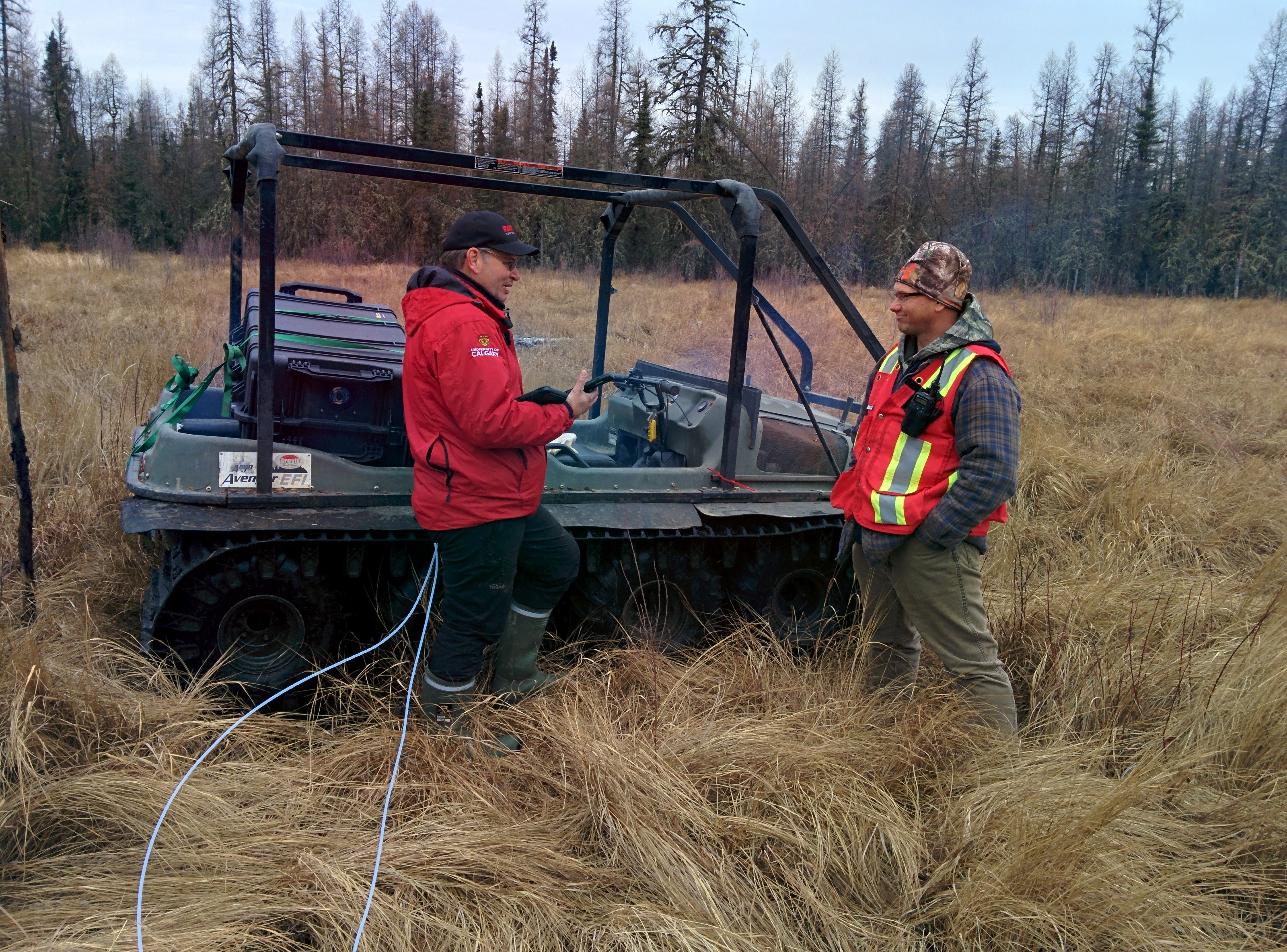Atmospheric leak detection as a tool for bitumen steam chamber and oil well integrity risk analyses
Lead Proponent: Saint Francis Xavier University
Location: Antigonish, NS
ecoEII Contribution: $ 300,000
Project Total: $ 539,000
Project Background
Oil sand deposits are in the form of bitumen, which in its natural state is too viscous to flow. When bitumen is too deep (>80 m) to economically extract via surface mining, steam is injected to warm the bitumen, reducing the viscosity and allowing it to be pumped through horizontal well pairs to the surface. Several potential environmental problems have been associated with extraction of oil sands including fish tainting, leaks, and oil spills. In 2013, a blow-out at Canadian Natural Resources (CNRL) Primrose facility in northern Alberta, leaked more than 26,000 barrels of steamed bitumen to seep into the boreal forest through ground fissures as long as 159 m, putting groundwater at risk. The incident drew attention to the connection between well integrity and the presence of fractures within the caprock zone above the reservoir. The presence of formation gases at the surface is the first indicator that problems with well integrity exists, since formation gases are far less viscous than bitumen and can sneak preferentially through fractures and wellbore failure areas. If a sufficiently sensitive surface gas measurement technique were to be used regularly for site surveys, well integrity problems (and/or over steaming issues) could be detected long before any bitumen or formation water were to reach the surface. To that end, St. Francis Xavier University (St. FX) proposed the project “Atmospheric leak detection as a tool for bitumen steam chamber and oil well integrity risk analyses” for ecoEII funding. The project was awarded $300K to develop a highly sensitive, large-footprint detection gas survey technique for oil sands producers.
Results

Two researchers stand beside the Argo, loaded with atmospheric leak detection technology, in a grassy, wetland in Christina Lake, Alberta.
-
Text Version
St. FX’s mobile leak detection technology is traditionally adhered to full size vehicles, and in this study it was adapted to be mounted on small vehicles, such as this all-terrain vehicle, so surveys could be conducted at sites without dense road networks. Project collaborators from University of Calgary and St.FX research technician, Alex Marshall, used this amphibious all-terrain vehicle to gather gas migration emissions data in Christina Lake, Alberta.
St. FX’s mobile leak detection technology was adapted. The technology involves measuring the concentrations of several key gases in proximity to the soil surface, and applying computational algorithms that compensate for the magnitude and variability of background gases that may be present naturally in the area, before comparing the gas fingerprint to those of possible leak sources. The instruments are mounted on a vehicle. For this project, the system was adapted to be mounted on small vehicles such as all-terrain vehicles or snowmobiles. Surveys could then be conducted at sites without dense road networks.
The expected composition and variability of natural background gases in the western part of Canada’s oil sands region were established from literature reviews and company consultations. Largely, the normal oilfield patterns of C1-C4 hydrocarbons (methane, ethane, propane and butane) are present, along with some associated gases, in any emitted plumes. The composition of ground source gases associated with leakage was also established. Background correction and other algorithms were optimized and adapted in order to incorporate background gas concentrations in the lower atmosphere unique to each oil sands site. Moreover, the sensor package for leak detection surveys and other instruments were re-configured.

Inside the truck cab, computers provide information to the two vehicle occupants, via monitoring equipment on the outside of the vehicle.
-
Text Version
The truck is in transit through farmlands and actively surveying local atmospheric gases. In the later half of the project, field campaigns were conducted to verify the atmospheric leak detection technology developed by St. FX. Using a research truck outfitted with mobile leak detection technology, drive around surveys were conducted to map out concentrations of several key gases in proximity to the soil surface. Before comparing the gas fingerprint to those of possible leak sources, computational algorithms were applied to compensate for the magnitude and variability of background gases that may be present naturally in the area. Advancement of gas leak detection technologies to measure and collect data on fugitive emissions will better inform oil sands operators of potential well or cap rock integrity issues and benefit the industry in Canada and internationally.
In the later half the project, field campaigns were conducted to verify the atmospheric leak detection technology developed. They were conducted at sites such as Cenovus Energy’s oil sands facilities, Shell QUEST carbon capture and storage facilities and Containment and Monitoring Institute’s Field Research Station. During all field campaigns, exhaustive surveys of site equipment were conducted, and emission plumes were logged and attributed (both geochemically and geospatially) to the most probable sources. Background ambient atmospheric concentrations of methane, hydrogen sulphide and other gases were also logged. In some cases, surveys were repeated to improve accuracy. Overall, it was determined that fugitive emissions appear to be very well managed at oil sands SAGD sites. When present, fugitive emissions were easier to identify than expected, even in high methane muskeg environments. At more southerly CO2 injection sites, there was appreciable CO2 noise with frequent combustion plumes on the landscape. Given that combustion sources also produce high CO2 anomalies, an approach involving additional gases was devised to allow these sources to be geochemically “peeled apart” in order to avoid false positives.
Benefits to Canada
Advancement of gas leak detection technologies to measure and collect data on fugitive emissions will better inform oil sands operators of potential well or cap rock integrity issues and benefit the industry in Canada and internationally.
Next Steps
In February 2017, St. FX signed a technology collaboration agreement with Altus Group for the exclusive worldwide commercialization usage rights of St. FX’s vehicle-based gas leak detection technology named “ExACT” (Emissions Attribution via Computational Techniques). ExACT will be further developed and able to estimate volumes, fitted with FLIR thermal imaging infrared cameras and miniaturized such that it can be mounted on unmanned aerial vehicles.
Page details
- Date modified: